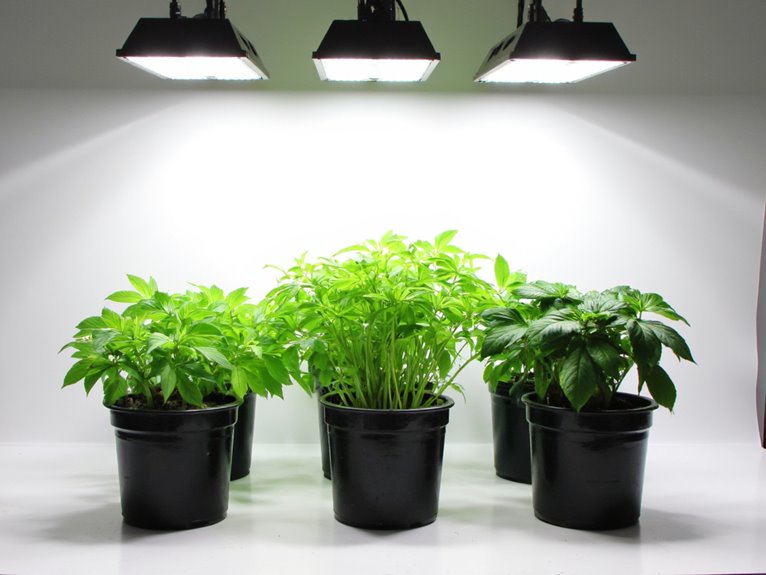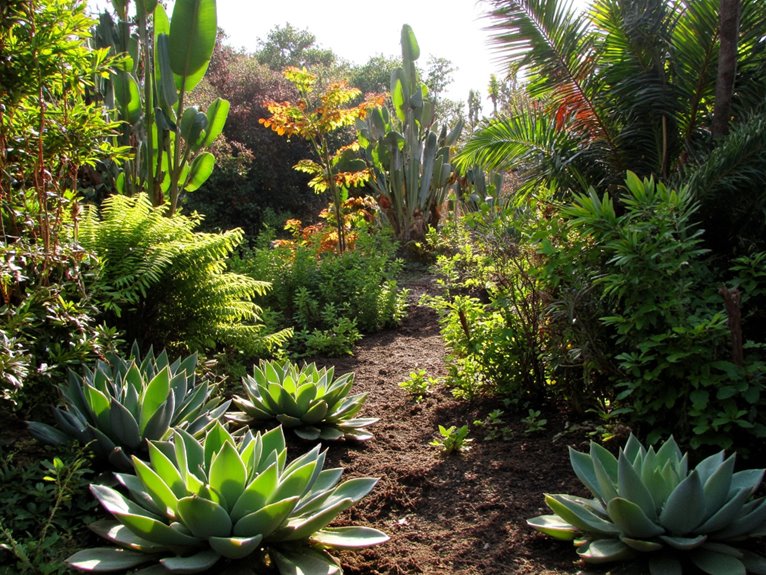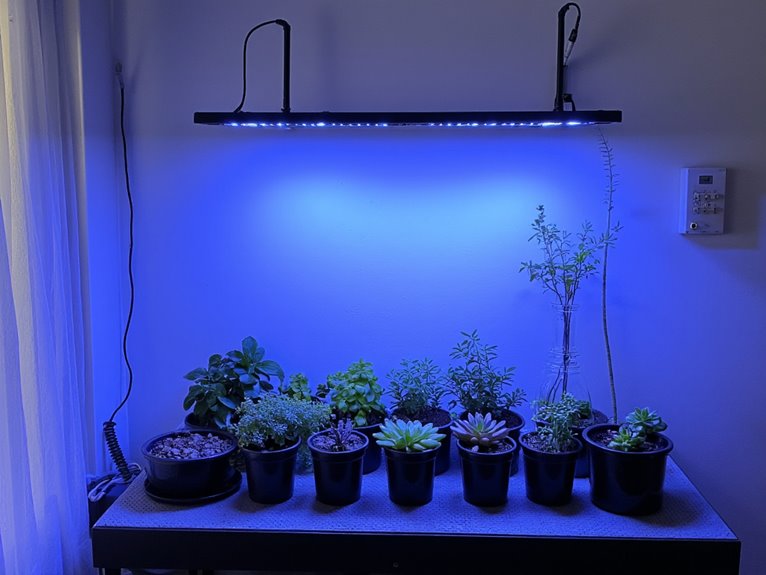Plant Location Selection Outdoors: Choosing Garden Spots Based on Light and Microclimate
Choose garden spots wisely by matching plants to their light needs—full sun, partial shade, or limited light—and considering microclimates like warm rock outcrops or cool shaded corners. Observe daily sunlight patterns and note temperature variations between areas; what thrives in one spot might fail elsewhere. Group plants with similar water and space requirements together for efficiency, and prioritize disease-resistant varieties that complement each other naturally. With these basics in place, you’ll set your garden up for success—and discover even more tips to transform your outdoor space into a thriving ecosystem.
Notable Insights
- Assess light exposure (full sun, partial shade) for each garden area to match plant needs.
- Create microclimate maps based on temperature variations from natural features like rocks or valleys.
- Test soil pH and nutrients to ensure optimal growing conditions for selected plants.
- Group plants by water requirements in hydrozones for efficient irrigation.
- Choose hardy, resilient species suited to your region’s climate zone and environmental conditions.
Assessing Light Requirements for Your Garden
Before you dig in, take a moment to evaluate how much sunlight each garden spot receives—this will determine which plants thrive where. Creating a light mapping of your yard helps identify spots receiving full sun, partial shade, or limited direct light. Partial sun and partial shade have distinct characteristics: partial sun areas can handle afternoon light while partial shade requires protection from intense mid-day and afternoon sun. Consider that afternoon sun can be intense even if mornings are mild; some plants show greater shade tolerance than others. Morning gardens might offer gentler conditions for tender seedlings, while full sun areas reward fruiting plants with abundant harvests. Remember that seasonal changes affect light exposure, so your light mapping should be reviewed annually. By matching plants to their ideal light conditions, you’ll create a thriving outdoor space that works with nature rather than against it.
Understanding Microclimate Influences on Plant Growth
How might your garden’s layout create hidden pockets of warmth or coolness? Microclimate variability shapes plant growth dramatically. A rock outcrop can raise temperatures by 10°F, while a valley floor may stay 10°F cooler than surrounding areas. Seasonal timing of budburst and senescence shifts with these subtle differences.
| Plant | Temperature Preference | Microclimate Response |
|---|---|---|
| Robinia | Moderate | Thrives in warmer urban microclimates |
| Tilia | Cool | Struggles with dry, hot microclimates |
| Maple | Spring warmth | Blooms earlier in south-facing locations |
| Fern | Shade | Benefits from moist, cool pockets |
| Sage | Well-drained soil | Prefers elevated areas with good air flow |
Microclimate conditions modulate phenology, water use efficiency, and growth rates. Understanding these patterns helps you place plants where they’ll thrive most. Thermophilization dynamics reveal how warming temperatures increasingly favor warm-adapted species in plant communities. When natural light conditions are inadequate, supplemental full-spectrum lighting can support plant establishment and early growth phases in challenging outdoor microclimates.
Evaluating Soil Quality and Composition
Once you’ve mapped your garden’s microclimates, evaluating soil quality becomes equally essential—because even the warmest spot can feel barren without the right foundation. Start with soil sampling: collect multiple subsamples across your plot, avoiding roots and debris, then mix them thoroughly before sending for nutrient analysis. Labs will measure pH, nitrogen, phosphorus, potassium, and other key elements, helping you determine if your soil needs amendments like lime or organic matter. A balanced texture—ideally loam—supports healthy plant growth by offering good drainage and aeration. Don’t overlook micronutrients either; deficiencies in zinc or manganese can stunt plants despite rich main nutrients.
Before planting, it’s crucial to test your soil’s pH level, as most plants thrive in slightly acidic conditions (6.0 to 6.5(#soil-ph-recommendations)), which optimizes nutrient availability and root development.
Water Availability: Finding the Right Balance
Whether it’s raining or you’re relying on a hose, finding the right balance of water for your garden is crucial—just like matching plants to their ideal spots. Effective water management starts with techniques like mulching, which cuts evaporation by half. Drip irrigation delivers water directly to roots, improving efficiency. Grouping plants by water needs (hydrozones) prevents waste.
| Technique | Benefit |
|---|---|
| Mulching | Reduces soil evaporation |
| Drip Irrigation | Direct root delivery |
| Hydrozone Grouping | Optimizes water use |
Water management also involves timing—watering early morning avoids mid-day evaporation. Modern irrigation methods like automated timers enhance consistency. Balancing these factors guarantees your garden thrives without waste. Consider that slow-release fertilizers can reduce watering frequency since they provide steady nutrition over extended periods, unlike quick-release options that require more frequent watering cycles.
Planning for Spatial Needs of Growing Plants
One key aspect of successful gardening is understanding how much space each plant truly needs—both above and below ground. Spatial arrangement matters: dense plant density can choke growth by limiting light, air, and nutrients. Measure carefully, using square foot grids or spacing charts to avoid crowding. Tall plants like tomatoes need 2-3 feet apart, while radishes thrive in packs of 16 per square foot. Consider root spread too—carrots need 4 inches deep, trees may require 10 feet wide. Balance is key: cluster compatible plants for efficiency but don’t pack them so tight they compete. When planning for large foliage plants, remember that adjustable height grow lights positioned 12-18 inches away can supplement natural light if spacing becomes limited. With thoughtful planning, your garden will flourish without overcrowding.
Selecting Plants That Thrive in Your Specific Site Conditions
After mapping out your garden’s layout, the next step is choosing plants that feel right at home in their new spot. Match light needs carefully—lavender thrives in full sun, while hostas prefer partial shade. Group companion plants with similar requirements to simplify care and optimize space. Consider seasonal variation when selecting blooms; some species will brighten spring while others dazzle in autumn.
For microclimates, select wind-tolerant varieties near fences or choose moisture-loving plants by water sources. Drought-resistant natives work well in dry areas, while ferns flourish in shaded corners. Pair complementary plants strategically—marigolds often benefit neighboring vegetables by deterring pests.
Think beyond appearance: consider how each plant’s needs align with your site’s unique conditions for a thriving outdoor space that evolves beautifully through the seasons.
Managing Environmental Stressors in Outdoor Gardens
Once you’ve chosen your plants, the real work begins with helping them handle their new environment, which is why understanding environmental stressors matters so much to garden success. Temperature management builds stress resilience – shade gardens cool extremes while windbreaks buffer frost. Water balance is equally crucial; both drought and overwatering disrupt nutrient flow. Position plants where they’ll receive balanced light without scorching, and use mulch to retain moisture. By addressing these factors thoughtfully, you’ll create a garden that thrives despite nature’s challenges. Remember, thoughtful placement transforms stress into opportunity for your plants to flourish.
Choosing Disease-Resistant and Pest-Tolerant Species
Having mastered environmental care, your next step is selecting plants that can defend themselves against common garden invaders. Focusing on plant characteristics like disease resistance and pest tolerance improves pest management and reduces maintenance. Let’s explore some resilient options:
| Plant | Resistance Traits | Ideal Use |
|---|---|---|
| Coneflower | Pest & disease resistant | Pollinator-friendly |
| Daylily | Hardy, low-maintenance | Border or foundation |
| Peony | Generally disease-resistant | Late-season color |
Choose species that match your garden’s conditions and complement each other. This builds a robust ecosystem where plants support one another naturally.
Using Hardiness Zones to Guide Plant Selection
When selecting plants for your garden, understanding hardiness zones helps you choose species that will thrive in your specific climate. These classifications divide regions by average winter temperatures, showing which plants can survive your area’s coldest conditions. Zone adaptation means picking plants rated for your zone or warmer—never colder. Check labels for hardiness ranges before buying.
While temperature is key, soil quality and sunlight also matter. A plant might survive the winter but fail if the soil drains poorly or gets too dry. In Texas, for instance, you’ll find both arid west zones needing drought-tolerant plants and humid east zones supporting different species. Don’t forget microclimates—your garden’s unique conditions can extend zone adaptation beyond official ratings. Start with what your climate offers, then build from there.
Frequently Asked Questions
How Does Wind Direction Impact Plant Placement in a Garden?
Wind direction shapes plant placement – face windbreak benefits toward harsh zones! Manage airflow by positioning taller plants perpendicular to prevailing winds, creating calmer microclimates for sensitive species.
Can I Use Mulch to Extend Growing Seasons in Cold Microclimates?
Yes, you can use mulch to extend growing seasons in cold microclimates. Mulch benefits by insulating soil, keeping it warmer and protecting roots from freeze-thaw cycles. It’s especially helpful for hardy crops like kale and spinach, letting you harvest later into fall or winter.
What Plants Work Best in Containers on South-Facing Walls?
You should pick container veggies, succulent varieties, flowering climbers, and colorful herbs for south-facing walls—like sunflowers, geraniums, rosemary, and sweet potato vine—that handle heat and dryness well.
How Do I Prevent Root Competition From Nearby Trees?
To prevent root competition from nearby trees, use root barriers to physically block invasive roots and be careful with soil amendments—add no more than 2 inches to avoid suffocating tree roots. Choose shallow-rooted plants for your garden beds.
Are There Species That Tolerate Urban Heat Islands?
Yes, there are species that tolerate urban heat islands. Heat resistant plants like dandelions and drought-tolerant succulents thrive in warmer cities. For urban gardening, choose native varieties that handle high temperatures and pollution. They’ll survive where others might wilt.
On a final note
As you prepare your outdoor garden, remember that thoughtful planning sets the stage for thriving plants. By matching species to light, soil, water, and climate conditions, you create a resilient landscape that rewards care. Embrace each season as an opportunity to learn and adapt—your garden will grow alongside you.






